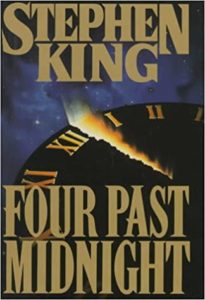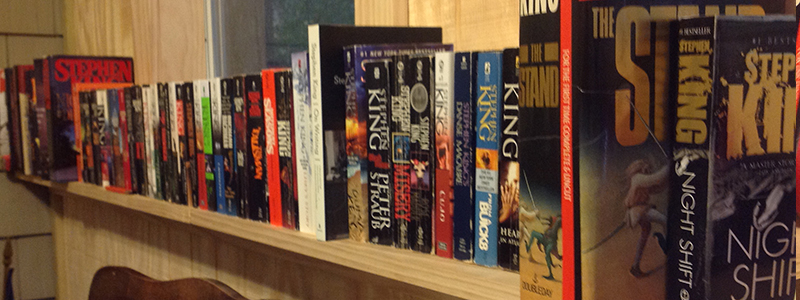by Jay Wilburn
The plan is to reread all of Stephen King’s works in the order that they were published. Richard Chizmar of Cemetery Dance had the vision. I’m doing it because I am a writer and I want to improve my fiction. And I love Stephen King’s stories. I think there is something to be learned through this process.
You can also go back to the beginning and read Before Carrie or any of my other posts up through this one and beyond by checking out this link to the Master List of all my #StephenKingRevisited posts.
All good babies lift your heads up …

My copy of Four Past Midnight, the same copy I’ve had since high school, had a sticker for $4.50 inside the cover from the used bookstore where it was bought. My laminated yearbook pass from my senior year of high school was inside where I’d used it as a bookmark.
We’ve hit the 1990’s in King’s work now.
“Straight Up Midnight” is the introductory essay in the front where King talks about sitting at home in July of 1989 watching the Red Sox play the Brewers. One of the Brewer players out of high school joined the team in 1974. That’s when King published his first book and he takes tongue-in-cheek offense at the announcers joking that this player helped lay the first foul lines, the old man of the team. Clemens is pitching, too, by the way.
King becomes career introspective in this essay, like he’s becoming the old man of publishing. It reads odd now knowing he had twice as many books and counting ahead of him than he had behind him — fifteen years of publishing behind him and over thirty years still ahead. But King becomes introspective about the things he’s finishing as he moves ahead. In 1989, his daughter is a sophomore in college, his oldest son plays a blues harp, and his youngest is still in little league. Both his sons are known for their writing now. “I’m not done yet.” That much of his predictions in this essay are true.
Much of the rest of the predictions in this essay and the ones that precede the novellas did not age well. Needful Things was supposed to be his last Castle Rock novel. I can’t recall if that held up. The Sun Dog is apparently a prologue to Needful Things. Secret Window, Secret Garden was supposedly the last story he was going to write about writers. That was a promise he broke often in the years that followed. He said he was no one’s National Book Award Winner in a rant before The Sun Dog on people asking him whether he would ever write anything serious. I believe that was the award he won in 2003. In his speech on that occasion, he talked again about people who thought he didn’t deserve that award. He talked again about being the outsider. He was in an “ending things” mode at age 42, when he wrote these essays. Hell, I’m older than that now and I feel like I’m still trying to get started.
Apparently, there was a two year period wherein he was supposedly retired. He doesn’t elaborate. I can’t remember now when he kicked his drug habits. We have to be somewhere near that territory, I think.
He talks about the perception of time being individual as a big theme in these stories. “A tale always has a tail,” King says, that he tries to grab ahold of.
Different Seasons was reviewed well, he says, as he discusses the four novella collection format that will become a staple of his catalog in later years. The novel Christine was not reviewed well, apparently. I recall quite enjoying that novel on my return visit. A number of other readers expressed the same on social media, although I had more than a few people who very much did not think highly of it. Bad reviews bother King, he confesses.
The Langoliers
This one was dedicated to his son Joe.
I remember loving this story during the first reading. It captured my imagination early in my exploration of King’s work. Especially in the expert build up in the air where we still don’t know what awaits on the ground. The surprise of what might be below the clouds was so good.
In the note on the story, King talks about the mental file of unwritten ideas. The bad ones self-destruct before they reach the page. He also admits to being a lazy researcher.
There is a great turn at the beginning of this story where one confrontation about a crisis turns into something else entirely.
We have a magic blind girl in this story.
“Never believe a writer. Listen to them, by all means, but never believe them.” Good line.
A character muses that you can’t go back and stop the Kennedy assassination. This might be seed of what became the story for 11/22/63, possibly King’s best novel.
The last forgetful moment that almost cost them everything was wonderfully done.
The way the story ended, I’m not sure how the plane wasn’t noticed sooner.
The Shop is mentioned, the shadowy organization that everyone in the Stephen King universe has heard of.
When Harry Met Sally is the inflight movie. One of the characters wears a Hard Rock Cafe tee shirt. The O.J. Simpson Hertz commercial is mentioned. They are allowed to have pocket knives on the plane. There are lobster tanks inside the Bangor International Airport. Gary Larson cartoons are mentioned.
This novella was really well-paced and full of action, good character moments, and suspense.
Secret Window, Secret Garden
“You stole my story” are the first words of this novella. “Right is right and fair is fair and something needs to be done about it.” The story really pissed me off in the beginning more than in the first reading back before I was writing professionally. The accusation of stealing a story really got under my skin this time.
There are a lot of points where not calling the police makes little sense in this story, but that’s kind of part of it.
“The ending seemed rather jejune.” Very literary magazine-ish.
His wife cheated on him at a motel in Derry.
There’s a real life gas station attendant in this story who pumps your gas and cleans the windshield for you. Payphones are significant to this story set in 1990. Using an encyclopedia to look up maps of a state and city names seems odd now.
The twist was a little predictable, but I think King was writing it for the audience to get it sooner on purpose. King still has his personality disorders mixed up. The intuition of the characters is just a little too strong and spot-on at the end. This is an ongoing problem in King stories.
The Library Policeman
I wasn’t looking forward to rereading this one. The dark twist reveal late in the story overwhelmed my memory of everything else that happened before that reveal during my first reading. This time through I appreciated the broader complexity of the story.
I’m not sure the staff and patrons of the particular public library would be all that excited about the dedication to them for this particular story where the librarian is a monster and bad things happen to the children.
It opens with a drunken acrobat. You can’t do much better than that.
The female lead character in the story has a distinctive voice that King captured. No funny accents. She just has a way about her that is understated and deeply human.
A man’s hair is turning white from fright and stress. We’re back to that again.
King describes “Midwestern Ugly” architecture. I found that very funny.
According to our devilish librarian, the children’s favorite movie in the summer survey was Nightmare on Elm Street part 5, their favorite band was Guns N Roses with Ozzy as runner-up, their favorite novel was Swan Song by Robert McCammon, and the runner up was Flowers in the Attic. An answering machine is important to the plot. There is exacting detail in the story on operating a microfilm reader.
Our monster in this may be a child of “It.” One of the little ones that got away at some point in the past, but goes back at least to the 1950’s and probably much further back than that. The universe of Tommyknockers seems to indicate that the force under that city is not dead.
This is a stronger story overall than I remembered. I’m glad I revisited it. It’s really a shame that we so rarely have the opportunity, or take advantage of the time, to read a story more than once with time in between those experiences.
The Sun Dog
John D. McDonald is mentioned in the dedication again.
The Sun 660 Polaroid camera is the star of this story.
I forgot that Reginald “Pop” Merrill is in this story. I’d also forgotten the portion where Pop drove around trying to sell the camera.
The faces in Castle Rock are more familiar to me this time around. Pangborn’s loses in the spring hit a little harder in this rereading.
I remember the details of the dad’s debt as the story started to unfold.
The disdain for summer people is sharp and clear in this story, same with most all of King’s characters in these Maine towns.
The battle between the tribes of reason and intuition for the human soul is played out well in this story.
Someone else’s hair turned white from fear in a story within a story in this one.
There’s a mention of Cujo again as this is not Castle Rock’s first crazy dog incident.
The family watches a rented copy of Child’s Play with Chucky on their VCR.
“It’s not the debt that hurts you; it’s the interest that breaks your back.”
My next post will be Before The Wastelands which will be linked on the Master List of all my Stephen King Revisited posts.





